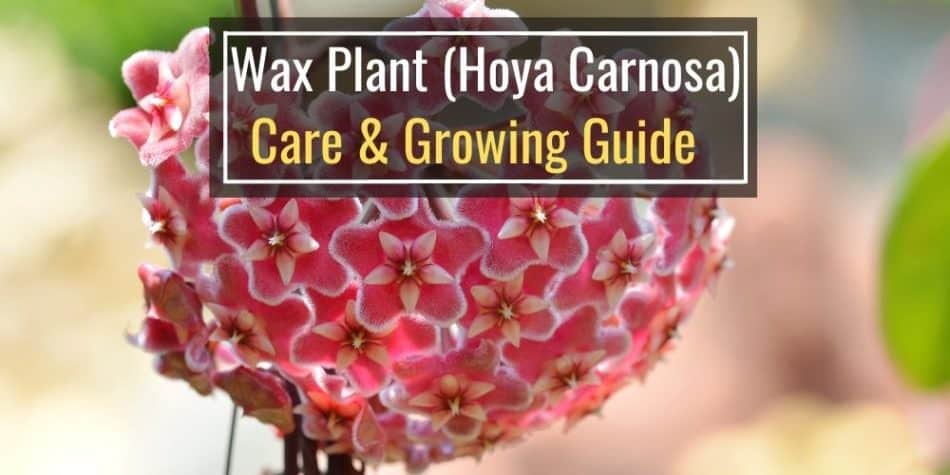Unlike most houseplants that only have decorative leaves, the Wax Plant or Hoya carnosa can produce beautiful flowers that release a pleasant aroma.
The wax plant is one of the best houseplants since it belongs to a group of plants that have the following desirable features:
- Climbing or hanging form
- Decorative leaves
- Fragrant flowers
- Easy to grow
Not only are wax plants beautiful and fragrant but they’re also beginner friendly plants.
This guide will cover everything there is to know about the wax plant so you can grow these beautiful plants in your home.
Plant Profile
Hoya carnosa is an evergreen climber from the Apocynaceae family, native to East Asia and Australia.
Wax plants have woody stems, which can grow up to ten feet tall. The leaves appear in pairs, one opposite the other along the brown-green stem. The leaves are ovate with a pointed tip, leathery, and shiny that grow 2 to 3 inches long. The leaves are dark green with discrete silvery spots and stains.
From early summer to autumn, the wax plant will grow flower balls on the short stalks that are composed of dozens of small, stellate flowers that are 0.5 inches in diameter. The flowers are mostly white with a pronounced red center that are about 3 inches in diameter.
The flower clusters have a pleasant but strong honey-like scent. These delicate white flowers look as though they are carved out of wax which explains the hoya carnosa’s common name – the wax plant.
Hoya Species and Varieties
The hoya genus includes over 200 different plant species. Among the 200 species is the hoya carnosa, which is the most popular and commonly grown houseplant. Typically hoya carnosa has green leaves but there are other varieties with variegated leaves and those with twisted leaf plates.
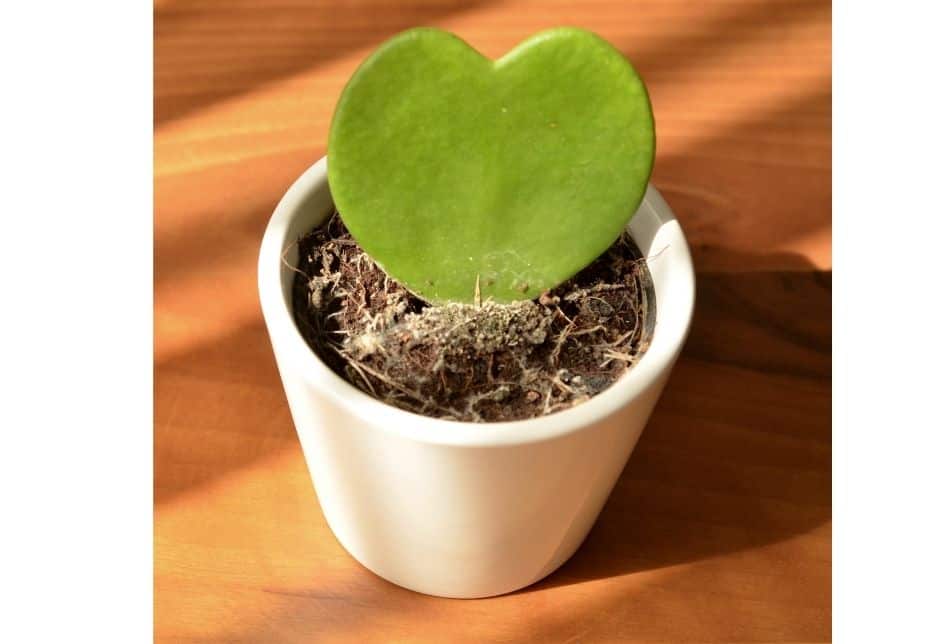
Hoya Kerii is native of Southeast Asia and has the common name Happy Heart due to its charming heart-shaped leaves. For this reason, it is often given as a gift on Valentine’s Day.
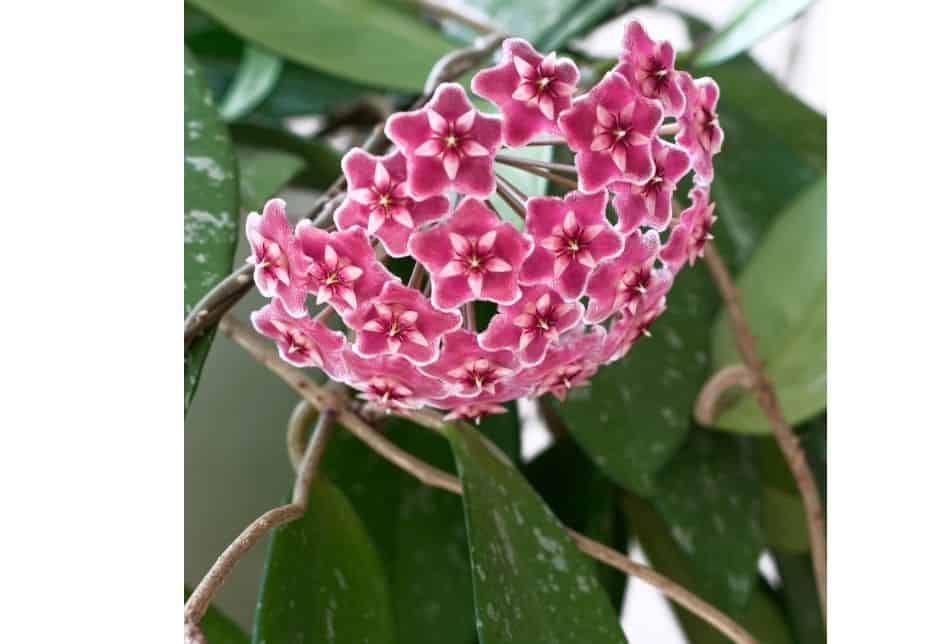
Hoya archboldiana is a large climber from Papua New Guinea where the monsoon climate prevails. Hoya archboldiana flowers come in many beautiful calyx colors ranging from pinkish white to deep pink. The single flowers are surprisingly large growing as wide as 1.5 inches in diameter, and can form inflorescences with a diameter of eight inches. More or less succulent leaves are oblong and reach 8 inches in length.
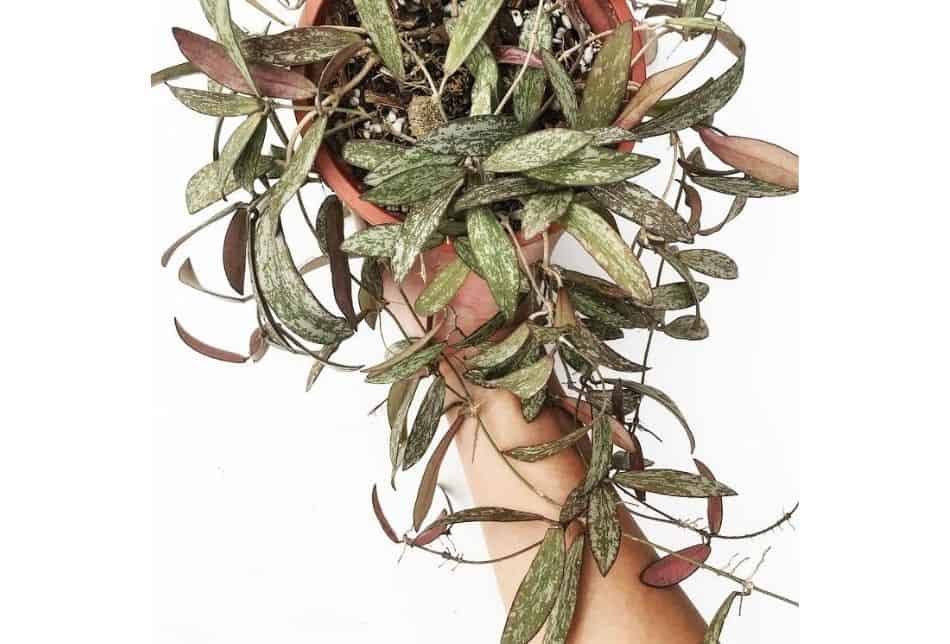
Hoya Sigillatis has decorative variegated leaves, with a reddish undertone in the sun. This plant thrives best in suspension in hanging baskets because it is not a good climber. Hoya sigillatis has beautiful pink flowers although flowering is not common.
How To Grow Wax Plants
Wax plants require bright indirect light, moist but not wet soil, humidity levels above 40%, moderate temperatures of 60°F to 80°F, and well draining soil. A typical household will provide the conditions that wax plants need to grow.
Wax plants will grow better in higher humidity above 50% which will also encourage more flowers to bloom. Make sure to repot a wax plant every two to three years to allow the plant to continue to grow bigger and healthier.
Light: Best Locations For Hoya Plants
In its homeland, the Wax plant is an epiphytic climber which grows under the bright trees canopy. Therefore, hoya prefer well lit areas that do not receive too much direct sunlight.
Although the leaves may look tough and leathery, the leaves will not tolerate too much direct sunlight. In fact, if the hoya receives too much direct sunlight then the leaves may curl and develop brown spots.
The best locations for hoya plants are near south or west facing windows where they will only receive 2 hours of direct sunlight and indirect light the rest of the day. North and east facing windows are less sunny so the hoya may need to be placed directly in the windowsill.
Hoyas can tolerate shady locations, but the plant will grow much slower and may never bloom.
Water: When To Water Hoyas
Hoyas have similar characteristics to a succulent. The thick leathery leaves can hold excess water, which means the hoya does not need to be watered frequently.
Here is a general watering schedule for Hoyas:
| Season | Watering Schedule |
|---|---|
| Spring and Summer | Once a week |
| Fall and Winter | Every 2 to 3 weeks |
Always allow the substrate on the surface to dry slightly before watering a hoya.
If you are not sure when to water a hoya then wait until the leaves shrink a little bit. The leaves shrinking is a sign that the water reserves of the plants are being depleted so the plant can be watered.
Similar to all other succulents, the wax plant can tolerate underwatering much better than overwatering. So make sure to allow any excess water to drain out and pour out any excess water that may accumulate in the pot’s tray.
Watering The Hoya During Winter
Hoyas will enter a dormant phase during the Fall and Winter months. Due to the plant’s dormancy, a hoya only needs to be watered every 2 to 3 weeks just so that the substrate is not completely dry.
It may look strange to see a hoya plant spend the winter in a dried substrate. However, hoyas prefer drier conditions and will bloom more intensely when spring comes around.
Do hoyas need distilled water?
Try to avoid tap water when watering a hoya as tap water may contain chemicals such as chlorine and fluorine. Additional chemicals or minerals can cause health issues for a hoya.
However, if you only have tap water then allow the water to stand for 1 hour before watering a hoya. Make sure not to use the water near the bottom of the pot as that will contain all the additional salts and minerals.
Soil: What kind of soil does the wax plant need?
Epiphytic plants like hoyas need soil that is both nutrient-rich and airy. Make sure that the soil is light and airy since this will allow the roots to dry out completely in between watering.
Here is a simple soil mixture for hoyas:
- One part cacti or orchid mixture
- One part perlite
Worm castings or other fertilizer can be added to the mixture to provide extra nutrients.
Just make sure that the substrate has additional perlite or pumice to allow the soil to dry out faster.
Fertilizing: Does Hoya need additional feeding?
Hoyas will benefit from additional nutrients through fertilizers but it is not necessary. Additional nutrients will encourage a hoya to grow faster and develop flowers.
Fertilize young hoyas once a month with fertilizer N-P-K ratios of (2-1-2) or (3-1-2) from spring to autumn.
However, once a hoya’s stem grows two or three feet long than use a fertilizer blend for flowering plants. Typically flowering fertilizers will have N-P-K ratios of (5-10-3) as the higher levels of phosphorous stimulates flower production.
Repoting: When To Repot Hoyas
Hoyas grow relatively small roots for their size and the roots grow slowly. So hoyas only need to be repotted when the rootball fills the pot which usually takes 2 to 3 years.
The best time to repot a hoya is in spring so that the plant can grow into its new pot during the growing season.
Make sure to transplant a hoya into a slightly larger pot to allow the roots to continue to grow. However, do not place hoyas into pots that are significantly larger as hoyas prefer to be root bound. Hoyas will bloom more when they are root bound.
Make sure that the pot or container has a drainage hole. Drainage holes are a must for hoyas since they do not like to sit in excess water.
Temperature: Are Hoyas sensitive to cold?
Wax plants are native to warm tropical regions which means hoyas are sensitive to cold temperatures. The coldest temperature hoyas can tolerate is 40°F.
So make sure the wax plant is placed in an area indoors that is heated or stays warmer than 40°F during winter.
Most homes have temperatures ranges from 60°F to 80°F which is exactly what hoyas prefer. Make sure that the hoya is not placed near a drafty area such as a walkway, window, or vent since large temperature swings can stress this plant.
Humidity: What humidity do hoyas need?
Hoyas are drought-tolerant plants which mean hoyas can tolerate low humidity levels of 30-40%. Typically a regular home has humidity levels in the 30-50% range.
Although hoyas can tolerate lower humidity levels, wax plants prefer humidity levels 50%+ which encourages the plant to grow larger and develop more flowers.
Three Simple Ways To Increase Humidity For Hoyas
- Misting the plant with a spray bottle
- Placing the plant on top of a pebble tray
- Using a humidifier
1. Mist Hoyas Daily
Misting the leaves is the easiest way to increase the humidity levels and, at the same time, remove dust from the leaves. Increasing the humidity levels through misting will slow down the transpiration process and reduce how often the hoya needs to be watered.
Mist the plant with soft water at room temperature and try to mist in the morning before the sun hits the plant. Avoid spraying the buds and flowers as the extra moisture can cause health issues for the wax plant.
2. Simple DIY Humidifier: Pebble Tray
Pebble trays are a simple and effective solution to providing more humidity to plants. A pebble tray is exactly what it sounds like – a tray full of pebbles.
In order to make a pebble tray:
- Select a shallow tray that is larger than the base of the plant’s pot
- Fill the tray with a single layer of pebbles
- Add water so it rises to about halfway up the rocks
That’s it! You have now created a simple but effective pebble tray for increasing humidity.
Next just place your plant on top of the pebbles and add water to your tray if it ever dries out.
3. Humidifier: Easy Way To Increase Room’s Humidity
An easier solution is to place a humidifier in the room with all of your tropical plants. A humidifier will allow you to adjust the settings to provide the right amount of humidity year round.
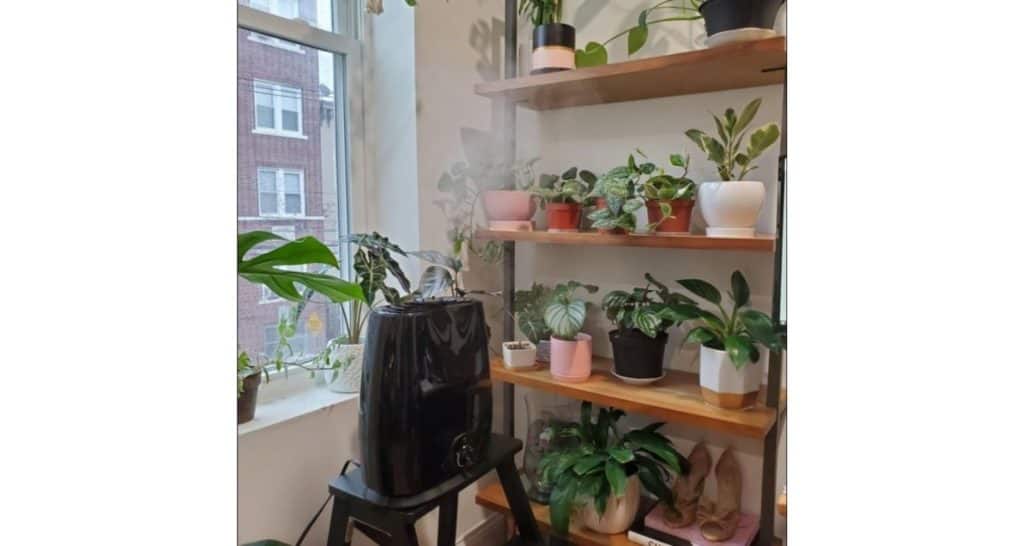
I use this humidifier in my room and the water reservoir lasts for about 2 days before needing to be refilled. I highly recommend it for a low-maintenance way of keeping the room humid for your houseplants.
Propagating: Starting New Hoya Plants
There are two methods for starting new hoya plants:
- Propagating a cutting in soil
- Rooting a cutting in water
1. Propagating Top Growth Cuttings In Soil
The best part of top growth cuttings is that these are normally created when you prune the wax plant. So while you are trimming your main wax plant, save the cuttings so you can start more hoya plants for your friends and family.
Follow these steps to propagate hoya cuttings in soil:
- Take a cutting 3 to 4 inches long that has at least two leaves.
- Be sure to take the cuttings in spring or early summer from the stem which bloomed last year.
- The ability to bloom is inherited so cuttings from a non-flowering stem usually transfer this trait to the new plant, which can delay flowering for several years!
- Insert the cutting into light and airy soil that drains thoroughly.
- Cover the cutting with a clear plastic bag to create a mini-greenhouse and place it in a warm and bright location.
- The plastic bag will help the cutting root from the warm and humid environment.
- Wait for 5 to 7 weeks until the cuttings develop roots and new leaves appear.
- Remove the plastic cover as soon as the first leaves appear and continue to nurture the plant as an adult.
A newly propagated plant grows slowly and usually takes 10 to 11 months to grow into a leafy plant 6 to 8 inches tall.
However, the cuttings will continue to grow into larger wax plants which means you have successfully propagated new hoya plants from cuttings.
2. Rooting Cuttings In Water
Hoya cuttings can be propagated in water instead of soil.
Simply follow these steps in order to see roots grow from the cuttings in water:
- Place the cutting into a glass with room temperature water.
- The stem node should be in the water while the leaves should be above the water surface.
- Do not allow the water level to fall below the stem node so add water when necessary.
- Wait 4 to 8 weeks until the roots start forming. You will visibly see roots growing from the base of the stem node.
- Transplant the baby plant into a smaller pot with light and airy soil that drains thoroughly.
A newly propagated plant grows slowly and usually takes 10 to 11 months to grow into a leafy plant 6 to 8 inches tall.
However, the cuttings will continue to grow into larger wax plants which means you have successfully propagated new hoya plants from cuttings.
Common Problems With Hoya Plants
Below are common problems and solutions with hoya plants.
Q: Why does my hoya plant have brown tips?
A: Hoya plants will develop brown tips when there is not enough water in the soil or the air. Water a hoya plant every week during the spring and summer while reducing the watering schedule to once every 2 to 3 weeks during fall and winter.
A less common reason for brown tips on a hoya plant are from overfertilizing. Too much nutrients and minerals in the soil will block the roots from being able to absorb the nutrients and water the plant needs to survive. Repotting the plant in fresh soil without any added nutrients will resolve any issue related to overfertilization.
Q: Why are the leaves of my hoya yellow and falling off?
A: Hoya leaves will naturally turn yellow and fall off since this is part of the natural life cycle of the plant. Typically the wax plant will shed off the lower leaves on the stem first. However, if the leaves turn yellow and fall off randomly along the stem then excessive watering is generally the cause of this issue.
Water a hoya plant every week during the spring and summer while reducing the watering schedule to once every 2 to 3 weeks during fall and winter. Hoyas are drought tolerant so underwatering is less harmful than overwatering.
Q: Can I save the rotting wax plant?
A: A rotting wax plant can be saved only if there are stems that have are not mushy or rotted. Overwatering a wax plant will eventually lead to root rot so remove the plant from the pot and try to remove any rotted portions of the plant. The remaining pieces of the wax plant can be repotted.
Pests: Do pests like the wax plant?
A: The wax plant is not particularly attractive to pests. However, common pests such as mealybugs, aphids, and spider mites may appear. Treat any pest infestation immediately with natural remedies such as neem oil or insecticidal soap. Personally, I recommend this homemade insecticidal soap since it is safe to spray around kids and pets.
Frequently Asked Questions
Q: Why doesn’t my hoya bloom?
A: Juvenile or young hoya plant will not bloom. Once a hoya plant matures, it will have at least one stem that is 3 feet long that will start flowering. Typically hoya plants need to be a few years old before flowering.
Q: How to make my hoya bushier?
A: Prune a hoya by shortening the shoots to the desired length by cutting below a node on the stem. Pruning will stimulate new growth and encourage the hoya to grow laterally instead of vertically which results in a bushier plant.
Q: Is Hoya carnosa a fast-growing plant?
A: Hoya carnosa is a slow growing plant that only grows about 4 to 10 inches during the growing season. Make sure to provide bright indirect light to a hoya carnosa to encourage the plant to grow as much as possible.
Q: Do Hoyas bloom every year?
A: After blooming once, the hoya plant will continue to bloom every year. Hoya plants always bloom from the same flower stalk so do not cut the stalks after the flowers wither. Try not to move the plant or change the plant’s conditions as this may also prevent the same hoya from blooming the following year.
Final Thoughts
There are many reasons why the hoya plants have been one of the most desirable and popular houseplants. Hoyas, also known as wax plants, are drought resistant, adaptable, and easy to grow.
Wax plants are beginner friendly plants that produce beautiful and fragrant flowers once the plant matures. Hoyas look exceptional in hanging baskets, wrapped around supports, or bent into shapes.
Check back to this wax plant care & growing guide to ensure that your wax plant continues to produce beautiful and fragrant flowers for many years to come.

